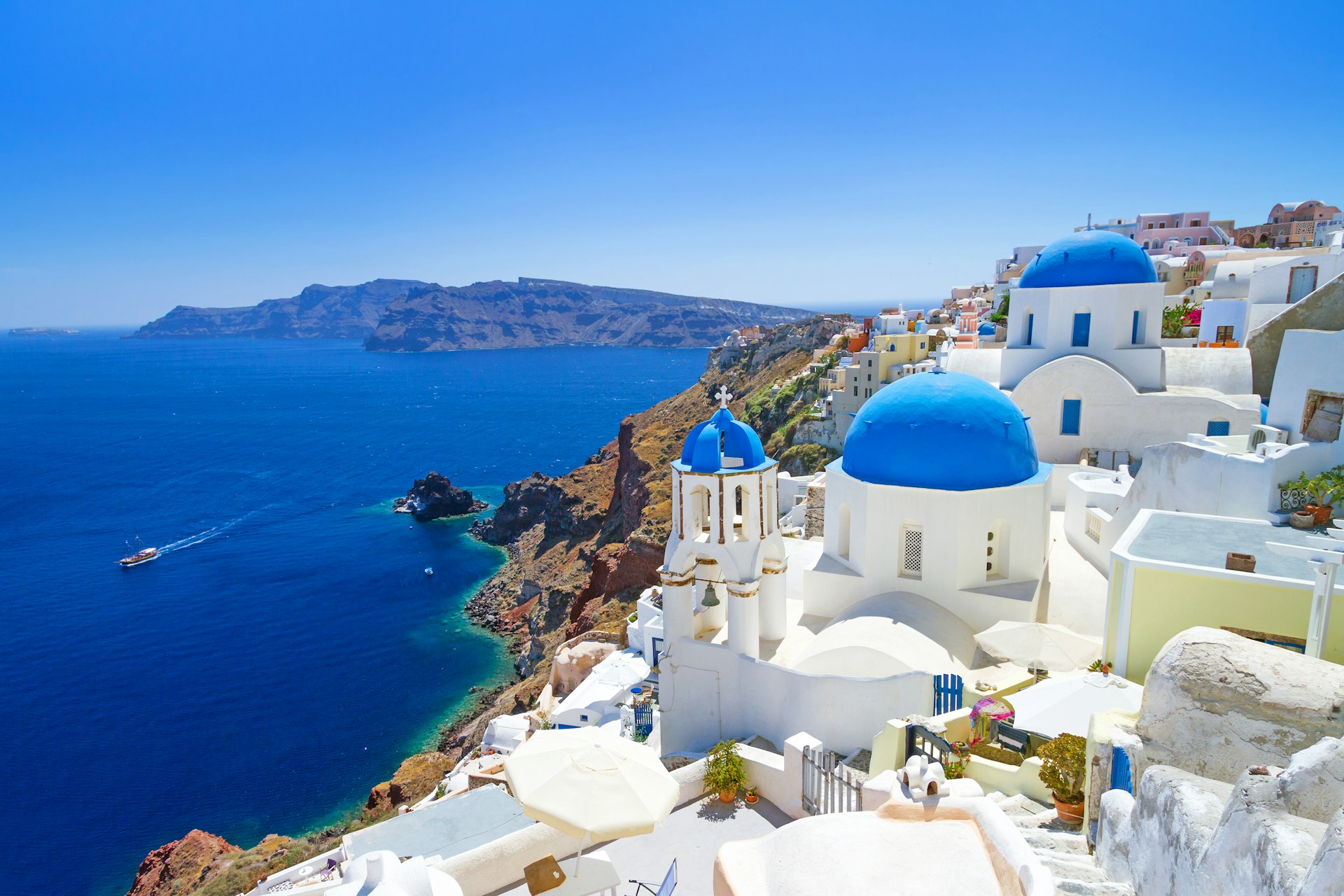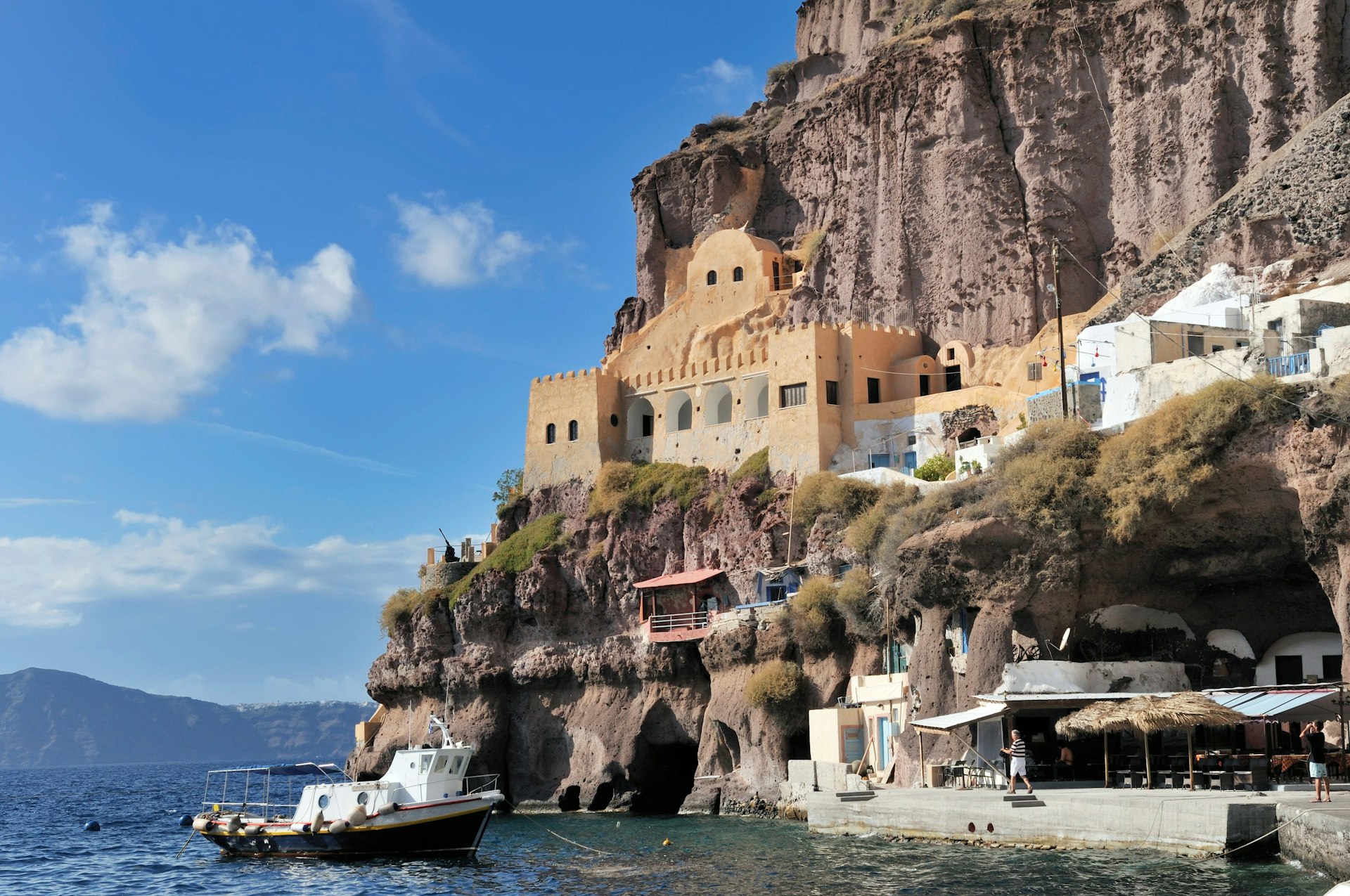Santorini is the supermodel of the Greek islands, a head-turner whose face is instantly recognizable around the world: multicolored cliffs soar out of a sea-drowned volcanic crater, topped by whitewashed buildings.
With its reputation for dazzling panoramas, romantic sunsets and volcanic-sand beaches, it’s hardly surprising Santorini features on so many travelers’ bucket lists.
If you’re planning to join the crowd, here’s your guide to Santorini to ensure your trip is one to remember.
When should I go to Santorini?
Peak travel time to Santorini is July and August, when temperatures and prices peak, and hotels, viewpoints and beaches are packed with tourists. Cruise ships deposit thousands of day-trippers to join the holidaying throngs. For better or worse, the island can feel like a crowded party.
For those in-the-know, the shoulder seasons from late April to June and September to October are the best months to visit Santorini. Things are marginally quieter at the caldera edge, and considerably quieter on the east coast. From May to October the weather is reliably sunny, and swimming is possible. Sea temperatures are more favorable in fall compared to spring.
All that said, don’t discount a winter break, when crowds are scarce (and prices low) while the scenery is still breathtaking. However, note that not all tourist places are open in winter. Tourism season kicks off in earnest from Greek Orthodox Easter (approximately mid-April).
Fancy extending your trip to mainland Greece? These are the top destinations to visit
How much time should I spend in Santorini?
Santorini can be expensive to visit (especially when you compare it to the lesser-hyped Greek islands), so your Santorini travel itinerary will depend on how far your budget stretches – and, in turn, this is highly dependent on what time of year you visit.
You need at least three days in Santorini to experience the best of the island – the caldera-edge views, a boat tour, some beach activity, and a dose of history and wine-tasting, too.
Is it easy to get in and around Santorini?
Frequent ferries and high-speed catamarans link Santorini with Athens’ main port of Piraeus, Crete and various Cycladic islands. Check OpenSeas for ferry timetables.
Santorini Airport has year-round flight connections with Athens, and direct summertime European connections.
On the island, bus services are decent, if crowded in summer. Lots of companies offer cars, mopeds and ATV four-wheeler bikes to rent. Walking is by far the best way to experience the caldera-edge clifftop towns.

Top things to do in Santorini
Views! Everywhere!
The top activity on Santorini is to walk the caldera edge and admire the gob-smacking views. Walks in and around Fira are spectacular, particularly heading north to Firostefani and Imerovigli along the caldera-edge pathway.
Keep walking and you’ll eventually reach Oia – a popular pastime, but be aware that it’s about 6.5 miles (10.5km) in total from Fira to Oia, and a good four-hour walk, one way. Carry water and sunscreen.
Nature’s handiwork is on display from any waterfront seat come sundown, but prime sunset-viewing on Santorini is in Oia, where thousands of tourists flock to admire nightfall.
Unearth history
Santorini’s intrigue reaches deep into the past, with the fascinating site of Akrotiri displaying a Minoan city destroyed by the volcanic eruption of 1613 BC. In Fira, the impressive Museum of Prehistoric Thera helps piece together the story of ancient Akrotiri.
Taste the island
Santorini’s local flavors are in the spotlight these days, and deservedly so. The island’s lauded wines are its crisp dry whites and the amber-colored, unfortified dessert wine known as Vinsanto. Both are made from the indigenous grape variety, assyrtiko. About a dozen local vineyards host tastings (usually with a small charge) and some offer food, with scenery and local produce combining to great effect. Start your investigations at SantoWines, or join a wine tour.
Take a tour
You might not think of yourself as a day-tour kind of traveler. But in Santorini, that might change. Any tour your heart desires can be organized, and there are dozens of agencies ready to help with winery visits, archaeology tours, sunset-watching and more. The most popular option is a cruise, and the classic itinerary takes in the caldera’s volcanic islands of Nea Kameni and Palia Kameni, including a stop at the former’s crater and the latter’s hot springs.
Do you want to experience Greece like a local? Try these “hidden” destinations

My favorite thing to do in Santorini
A caldera walk is always high on my agenda: come for the views, but stay for the fabulous Santorini surprises, including an innovative brewery, wine caverns adorned with artworks, and cooking classes that celebrate the island’s blossoming food focus.
After a day on a trail or a beach, my favorite evening activity (well, second to sunset-watching) is checking out what’s playing at the gorgeous, tree-lined open-air cinema in Kamari. Cheesy movie, deckchair, popcorn, local beer: now I’m on vacation!
How much money do I need for Santorini?
Accommodation will be your biggest expense on the island. If you can afford it, first-timers should stay on the caldera edge to experience the full wow factor. Fira, Firostefani, Imerovigli and Oia have hotels and villas with whitewashed interiors, terraces and infinity pools that have inspired marriage proposals, high-fashion photo shoots and many Instagram posts. Unfortunately, there are not a lot of places to stay in these view-blessed locales for budget-conscious travelers: caldera-view accommodations are expensive, and they’re in hot demand.
There are decent midrange options in Fira and Firostefani (less so in Imerovigli and Oia), away from front-row panoramas of the caldera. There’s also a great hostel and a campground (with rooms) on the outskirts of Fira. If you’re more interested in a beach break or activities, stay in Perissa or Kamari (and catch the bus into Fira). The advantage of this is some respite from the camera-toting caldera crowds, plus more reasonable prices.
Food options span the spectrum, from budget gyros to super-swank fine dining. The best activities are free: follow a walking trail, watch the sun set.
There are good ways to spend time without it burning a hole in your pocket: rent a sunlounger on the sand, visit a museum to investigate storied ruins. A day tour is always a hit: sightsee from a boat or visit local wineries. A visit to Ancient Akrotiri costs €16.
- Basic room for two: Away from the caldera’s edge in Fira in July, a dorm bed goes for around €50
- Double room at a resort: A guesthouse double room can be found for €120 to €160 per night, a self-catering apartment for two begins around €180.
- Lunch at a local market: Gyros costs between €5 and €7
- Main meal at a restaurant: €25
- Bottle of beer at a bar: €4
- Boat tours: Range from about €50 to €100 per person
- Bus ride in Fira: Varies between €1.80 and €2.50
- Taxi from the international airport: To the center of Fira is approximately €15 - €20

Enjoy Santorini’s main clifftop towns
Santorini’s main tourism is focused on the caldera-edge clifftops in the island’s west, with large clusters of whitewashed buildings nesting at dizzying heights, spilling down cliff-sides and offering gasp-inducing views from land or sea. Fira, the island’s busy capital, sprawls north into villages called Firostefani (about a 15-minute walk from Fira) and Imerovigli (the highest point of the caldera edge, about a 30-minute walk from Fira). A path running through these villages is lined with upmarket hotels, restaurant terraces and endless photo opportunities.
These three conjoined settlements draw most visitors, together with the stunning and upmarket village of Oia in Santorini’s north. There’s a growing number of hotels in the island’s south, offering caldera views looking north and northeast. Akrotiri’s views come cheaper than Oia’s, but it’s a fair way from the action of Fira.
Don’t miss the lesser-celebrated east coast
Santorini’s east coast is lesser known than the celebrated, elevated west coast. Here, the caldera-edge heights have sloped down to sea level, and volcanic-sand beaches and resorts offer a very different drawcard.
East coast resorts such as Kamari and Perissa have a more traditional (and more affordable) island-holiday appeal: sunlounger-filled beaches, water sports, and taverna-lined promenades. The east coast’s beaches are lined with black sand. On the south coast, there’s a string of beaches famed for their multicolored sand. The dramatic Red Beach is a traveler favorite.
The island’s interior is dotted with vineyards and traditional villages that let you see beyond the tourist hustle. Make a stop in Pyrgos for great eats and a wander through charming backstreets.
This article was first published May 16, 2019 and updated Jun 11, 2024.
